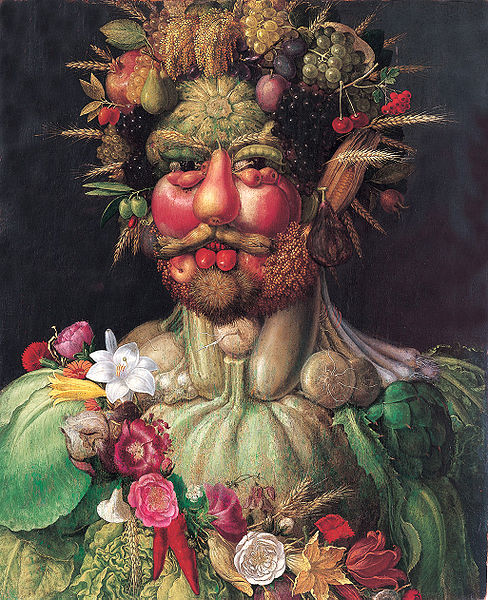 The Blanton Museum in Austin, Texas, is now showing Sam Taylor-Wood’s 2001“Still Life,” a three-minute video of fruit on a plate, rotting. The time-lapse images are transfixing, engaging your senses as you watch fruit decompose, moment by moment. (http://www.youtube.com/watch?v=BJQYSPFo7hk)
The Blanton Museum in Austin, Texas, is now showing Sam Taylor-Wood’s 2001“Still Life,” a three-minute video of fruit on a plate, rotting. The time-lapse images are transfixing, engaging your senses as you watch fruit decompose, moment by moment. (http://www.youtube.com/watch?v=BJQYSPFo7hk)
Food and art have enjoyed each other’s company for centuries. Rudolf Arcimboldo’s 16th century painting, “A Feast for the Eyes,” is an classic art/food mashup. (http://media.smithsonianmag.com/images/Arcimboldo-Rudolf-II-631.jpg.)
Food is also fodder for contemporary performance artists and designers. Marti Guimé’s book Food Designing and Marije Vogelzang’s Eat Love portray food in tantalizing, subversive contexts, turning food as material culture into multimedia, multisensory experiences.
At first Taylor-Wood’s plate of pears, grapes, and apples appears static and your eyes search for meaning, observing the stems and small, brown defects of the pears’ skin. And then, as though taking its last breath, the fruit seems to slightly inflate, inhaling one last time before disintegrating, spoiling, rotting, into a final scene where the fruit, consumed by insects, now white, hoary with rot and spumes of gauzy mold becomes a nauseous disgorgement of putrefaction, amoebic shapes insinuating their original form.
How does a video that includes moving images of rotting fruit acquire the title “still life” in the first place? It’s hardly still or a celebration of life. Or is it? “”Still-Life” is part of a Blanton exhibit that describes ordinary objects that are “beguiling, loaded with narrative and metaphor,” which is another way of saying that the works of art aren’t what they seem to be.
A few years ago I visited the Institute of Contemporary Art (ICA) in Boston. The museum had just moved into an audacious building at the edge of the waterfront and was drawing crowds eager to see new exhibits.
One room included an example of “performance art,” a pile of clothing pushed into a corner. Seemed like the emperor indeed had no clothes, at least at the ICA. By the time I returned home from the exhibit I felt compelled to react to what seemed at the time a display of an artist’s complete lack of creativity. But, for a week, I tossed down my clothes each night and took a photograph. By the third night, I was rearranging the clothing, observing where colors and textures overlapped or where the composition seemed out of balance, overwhelmed by a pant leg or disconnected from an orphaned sock.
The surprise came at the end of the week when I posted the gallery of photos here:
http://www.flickr.com/photos/90414796@N05/sets/72157635382777662/
Aha, I had become the perfect participant in the performance of art at the ICA, provoked to react, pushed to think more about the meaning of art. The pile of clothes wasn’t just a pile of clothes. The exhibit beguiled me, like the rotting fruit, just as the fresh apple beguiled Eve, into believing that clothing had other stories to tell.
Seems the convergence of art, science, and food is underway. Meanwhile, I can never look at a pile of clothes or a plate of fruit in the same way, can you?
Love this post, Robyn! I took Julian to that Blanton exhibit this summer, and he didn’t believe that the video of the rotting fruit was real. (He was convinced that it was CGI.)
As for the provocative nature of performance art (or contemporary art in general), I had the same reaction to the retro kitchen in that Blanton exhibit. How many kitchens have I been in that looked exactly like that but weren’t considered “art,” but the more I thought about the beauty of quotidian, even outdated design, the more I could appreciate the effort that went into recreating it for the exhibit.